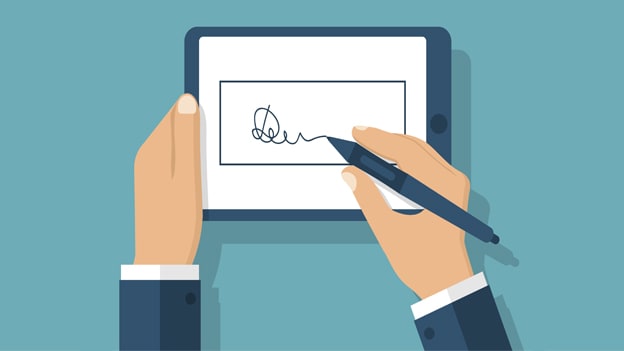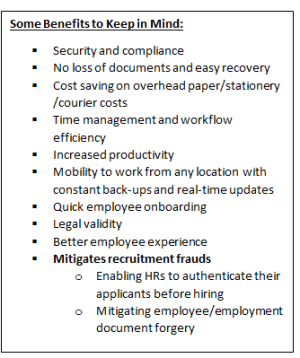Enabling HRs with the power of digital signatures

For HR professionals, collecting signed paperwork is tantamount to herding sheep—there is always one missing. This is why the technology that enables digital signatures has come as a godsend to harried HR executives as it makes a paper-intensive environment like the HR department more efficient and streamlined—and less cluttered! Since digital signatures speed up document processing and efficiently gather vital employee data, NDAs, insurance forms, performance reviews, etc., they have become indispensable to HR departments.
Today’s organizations understand the need to modernize their departments through technology-enabled platforms that utilize digital signatures in all HR processes. The application of this technology has led to increased productivity and a substantial reduction in the costs towards printing, paper, ink, and storage needs.
How do digital signatures work?
Signatures can be generally defined as a mark or sign made by an individual which signifies his or her knowledge, approval, acceptance or promise. However, a digital signature implies a legally recognized form of acceptance mapped to an individual’s identity in a foolproof manner that utilizes sophisticated technology to ensure the integrity of data being signed for eternity. As the name suggests, a digital signature is created on a digital platform, which is encrypted and unique to every user with authentic identities. For the average user, digital signatures are like ‘fingerprints’, each unique from the other.
Like coded messages, these signatures link the user to an electronic document in a recorded transaction. To provide the highest level of security, most digital signatures today are built on a PKI (Public Key Infrastructure) framework which makes it impossible to replicate or digitally fabricate them. Any tampering of the document post its signing makes the signature invalid and legally void.
Kill your paper monster
Over the years, handling reams of paperwork has been the biggest bottleneck faced by HR professionals. The migration to digital signatures has been a huge technological shift for HR departments, enabling them to improve employer-employee interactions and gain an edge in these competitive times.
To put this in perspective, let’s look at a scenario of an organization with 200 employees. Imagine the paperwork if each employee on an average generates twenty new documents per year. Moreover, if new employees are brought on board, the HR department will have to process additional paperwork such as confidentiality agreements, benefit forms, etc. This works out to an additional ten documents or so from each new employee. Mind you, one hasn’t even included leave approvals, terminations, reimbursement forms, etc. to the mix!
The voluminous paperwork resulting from generating, maintaining and archiving such employee-related documents demonstrates how document management could be a major challenge and an added expense for any HR team. Hence, as HR departments are racing to join the digital future, they have readily embraced digital signatures as it not only offers legal validity, but also helps organizations go paperless, while reducing costs across departments, and simultaneously providing transparency and convenience to both HR personnel and employees.
Digital Signatures: You can’t ignore the benefits

The use of digital signatures is becoming increasingly common in HR functions as employers find themselves in situations where handwritten signatures are no longer practical when there is an inflow/outflow of large volumes of paperwork. Signature-based solutions help HR professionals streamline their internal processes while hiring new employees.
Employee paperwork generally requires many physical signatures which make the process time-consuming as each document will have to be individually processed. This is why digital signatures have replaced the traditional paper signatures as the former help recruiters work faster and more efficiently. Even legal documents like NDAs can be issued on pre-drafted templates where the employee will only need to sign it with his or her digital fingerprint. A digital signature generates biometric proof that gives it a strong legal standing. With digital signatures being legally binding, companies can stay compliant with vital laws and audit processes, making sure discrepancies are reduced, especially while processing employee tax forms.
Digital signatures also make employee onboarding a simple process and free up time for HR personnel to focus on developing strategies to make their department future ready. Using digital signature technology, the required documents are sent to the new employee that he or she signs, triggering a digitally authenticated signature. Thanks to this revolutionary technology, neither the HR department nor the employees have to deal with temperamental printers, lost forms, or unpredictable overnight couriers.
The power of digital signatures
India’s rapidly growing economy has paved the path for immense job opportunities. All existing and new HR departments have realized the massive benefits of using digital signatures. Historical paper-driven processes are rapidly being transformed to digital processes across multiple organizations to effectively reduce cost and ensure competency in the local and global markets. In the next five years, as more companies incorporate digital signatures into their systems, this radical technology will no longer be considered niche but become integral to the mainstream HR process.














